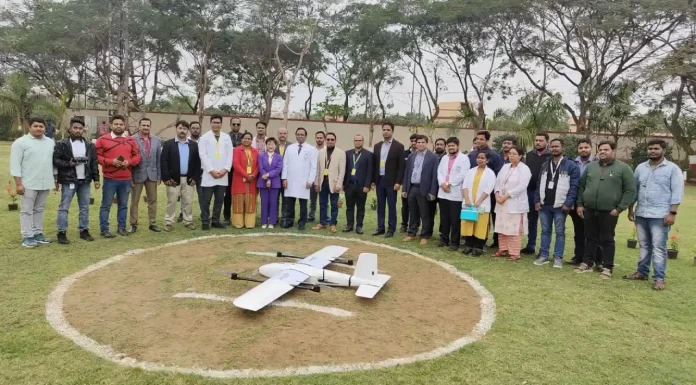Dronification is rapidly becoming a reality in India, driven by advancements in technology and a supportive regulatory environment. The Indian drone market, valued at approximately $1.21 billion in 2021, is expected to grow to $1.81 billion by 2027, reflecting a compound annual growth rate (CAGR) of 10.23%, according to the World Economic Forum. This growth is underpinned by the diverse applications of drones across sectors such as agriculture, infrastructure, delivery services, disaster management, and defence.
In agriculture, drones are improving traditional farming practices. Precision agriculture, enabled by drones, allows for detailed monitoring of crops, soil, and irrigation systems, enhancing productivity and reducing resource wastage. For instance, drones can cover up to 1,000 acres per day for pesticide spraying, significantly reducing the time and labour required compared to manual methods.
According to a report by the Niti Aayog, the adoption of drone technology in agriculture could boost productivity by 15-20% and reduce input costs by 20-25%. During the kharif season in 2021, a pilot project using drones for pesticide spraying in Andhra Pradesh and Punjab resulted in a 15-20% increase in crop yield and significant reduction in pesticide usage.
More recently, drone company Drone Destination signed an agreement with cooperative major IFFCO for spraying agricultural products on up to 30 lakh acres of farmland across 12 states including Andhra Pradesh, Bihar, Gujarat, Haryana, Karnataka, Madhya Pradesh, Maharashtra, Punjab, Rajasthan, Telangana, Uttar Pradesh, Uttrakhand.
According to company officials, under the agreement Drone Destination could get paid in the range of Rs 400 to Rs 800 per acre at prevailing market rates, implying that the deal will fetch a revenue of Rs 120 crore in the lower price band and up to Rs 240 at upper price band.
Growth underpinned by cross-sector applications
The infrastructure sector is also witnessing the transformative impact of drones. They are extensively used for surveying, mapping, and monitoring construction sites, leading to improved accuracy and efficiency. The utilisation of drones in the various government projects are expected to expedite project completion and enhance urban planning.
Notably, the National Highways Authority of India (NHAI) has used drones for monitoring highway construction projects, resulting in a 25% reduction in project timelines and a 15% decrease in overall costs. A report by PwC India highlights that the integration of drones could save up to 20% in construction costs and reduce project timelines by 30%.
Delivery services represent another significant opportunity for drone technology. Companies like Swiggy and Zomato are piloting drone delivery programs to enhance efficiency and reduce delivery times, especially in remote and inaccessible areas. The Ministry of Civil Aviation's liberalised Drone Rules, 2021, have created a conducive environment for such innovations by simplifying the approval process and reducing compliance burdens.
In June 2021, Swiggy partnered with Garuda Aerospace to test drone deliveries in Bengaluru and Delhi-NCR. The trials demonstrated that drone deliveries could reduce delivery times by up to 30 minutes, making last-mile delivery more efficient. Similarly, state governments such as Telangana and Arunachal Pradesh have experimented with the innovative use of drone technology for quick delivery of approved medicines to far-flung rural areas and vulnerable communities.
Drones also play a crucial role in disaster management by providing real-time data, aiding in search and rescue operations, and delivering supplies to affected areas. They provide real-time data, aiding in search and rescue operations, and deliver essential supplies to affected areas. During the recent floods in Assam, drones were used to deliver medical supplies and food to stranded communities, showcasing their potential in emergency response.
During the floods in Kerala in 2018, drones were used extensively to survey flood-affected regions, deliver food and medical supplies, and assist in rescue operations, significantly improving the efficiency of disaster response efforts.
In the defence sector, drones have become integral for surveillance, reconnaissance, and combat operations. The Indian Army, Navy, and Air Force are increasingly deploying drones to enhance border security and combat capabilities. The government's push for indigenisation of defence equipment, under the Make in India initiative, is driving the development of advanced drone technologies domestically.
A report by the Ministry of Defence highlights that indigenous drone development can save up to $2 billion annually in imports. A notable example is the deployment of indigenous drones like the DRDO's Rustom-2 for surveillance along the Line of Actual Control (LAC) with China, which has strengthened India's border security and provided real-time intelligence to defence forces.
Challenges hinder the widespread adoption
Despite the promising prospects, several challenges hinder the widespread adoption of drones in India. Regulatory hurdles remain a significant barrier. While the DGCA has established guidelines for drone operations, the regulatory landscape is complex and often challenging for businesses and individuals to navigate. The need for a streamlined and transparent approval process is critical to fostering innovation and adoption.
Technological limitations also pose challenges. The domestic drone industry heavily relies on imported components, particularly from China, which hampers the growth of a self-reliant ecosystem. Despite the government placing a strict restriction on Chinese parts and software to be used in drone manufacturing in the interest of national security, some of the players are still relying on it in civilian use cases.
Both industry bodies such as the Drone Federation of India (DFI) and homegrown players like IdeaForge, PDRL, and Big Bang Boom Solutions, among others, are striving to improve the quality of drone pilot training and promote the ‘Make in India' initiative, while ensuring that the sector's burgeoning growth remains uncurtailed.
Efforts to enhance research and development (R&D) capabilities and boost domestic manufacturing are essential to overcoming these limitations. The Production-Linked Incentive (PLI) scheme for drones and drone components, launched by the Ministry of Civil Aviation, aims to address this issue by promoting local manufacturing and innovation.
Privacy and security concerns are another critical challenge. The proliferation of drones raises issues related to unauthorised surveillance and data breaches. Ensuring robust security protocols and compliance with privacy regulations is crucial to addressing these concerns and gaining public trust.
The shortage of skilled professionals capable of operating and maintaining drones is a significant bottleneck. Developing a skilled workforce through training and education programmes is essential for sustainable growth in the drone industry. Initiatives like the National Skill Development Corporation's (NSDC) drone training programmes are steps in the right direction. But merely providing a 4-days training with one-day with actual handhold on the field is not sufficient to produce the quality drone pilots.
Looking ahead
Looking ahead, several measures can facilitate the growth of dronification in India. Policy and regulatory reforms to create a supportive environment for innovation and business are imperative. Streamlining the approval process and reducing compliance burdens will encourage investment and adoption across sectors.
Technological innovation is vital for the advancement of the drone industry. Investing in R&D to develop cutting-edge technologies and reducing dependence on imports will strengthen the domestic ecosystem. The government's initiatives, such as the PLI scheme and the establishment of drone testing corridors, will play a crucial role in this regard.
Capacity building through training and certification programmes will help bridge the skill gap. Collaborations between educational institutions, industry, and the government can create comprehensive training modules, ensuring a steady supply of skilled professionals. Public-private partnerships (PPPs) can accelerate the adoption of drones by pooling resources and expertise. Successful PPPs can drive large-scale projects in agriculture, infrastructure, and disaster management, demonstrating the practical benefits of dronification.
International collaboration is also essential for fostering innovation and knowledge transfer. Partnerships with countries like the United States, Israel, and Japan can help India access advanced technologies and best practices, propelling the domestic drone industry forward.
Dronification in India holds immense potential to transform various sectors and drive economic growth. Addressing regulatory, technological, and workforce challenges is crucial for realising the full potential of drones.








